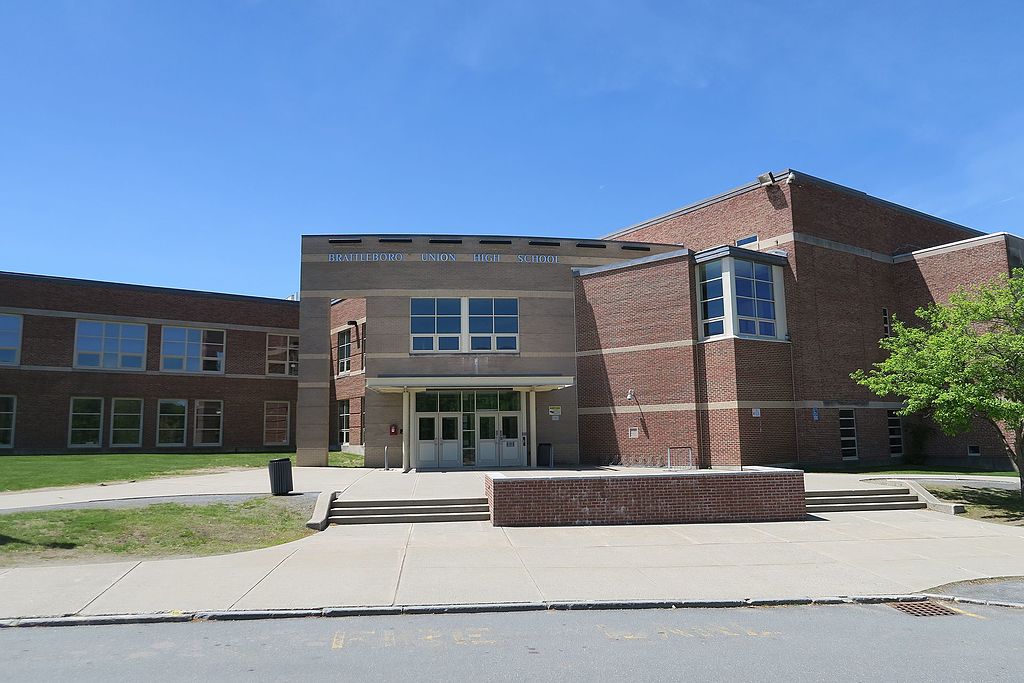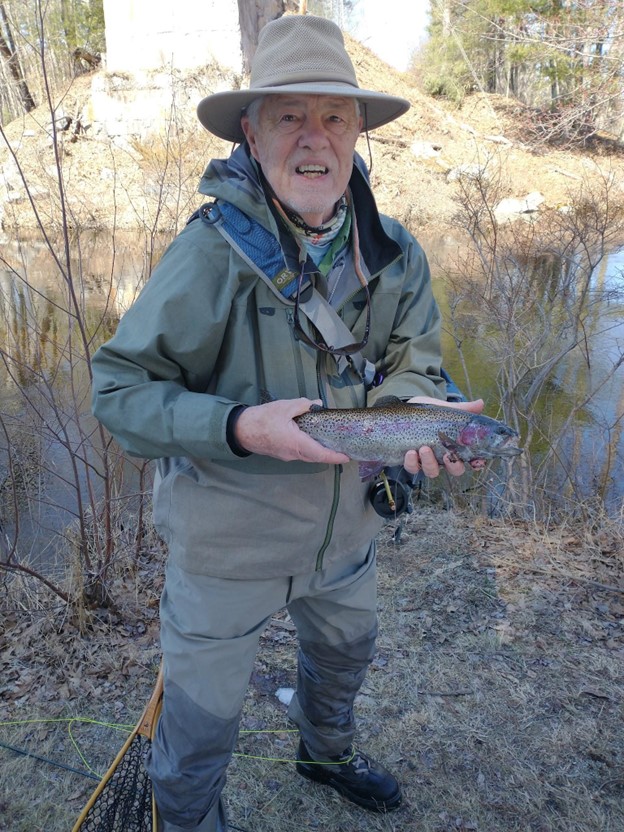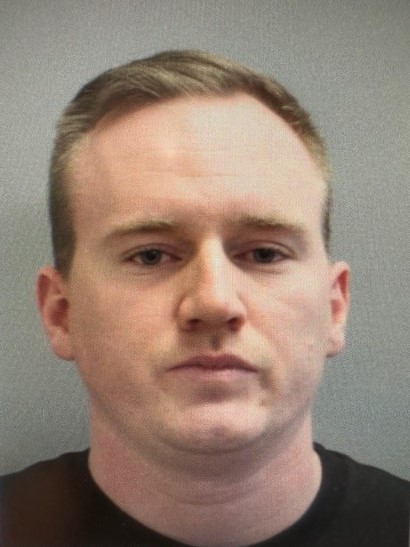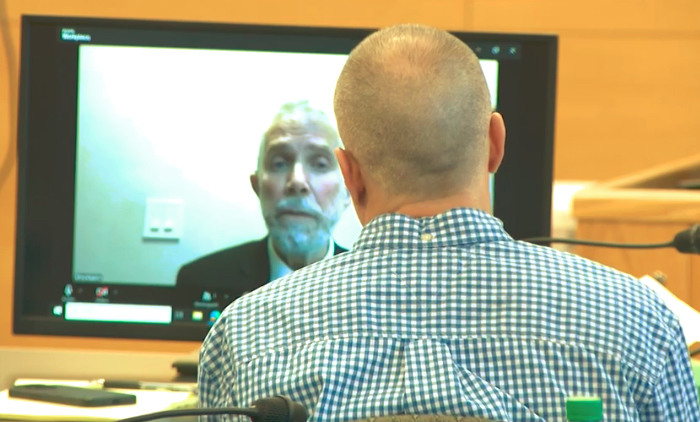Regardless of their income, residents of small Vermont towns can use state vouchers to send their children to boarding schools and ski academies. Some school-choice advocates want to replicate the program nationwide.
By Annie Waldman,
ProPublica
A self-made Vermonter, Glenn Bowman has sent both his children to out-of-state prep schools. His son plays lacrosse and football at Phillips Exeter Academy in New Hampshire, and his daughter studied advanced dance at Deerfield Academy in Massachusetts.
As the owner of a successful soapstone company that’s been featured on Martha Stewart and mentioned in The New York Times, Bowman could pay the $50,000-plus annual tuitions at each school out of his own pocket, he said.
But he doesn’t have to.
Because Londonderry, the small town where the Bowmans live, has no high school, they qualify for Vermont’s voucher program, the nation’s oldest. It contributes about $15,000 a year toward each tuition, ultimately saving Bowman more than $100,000 overall on his children’s high school educations.
Bowman chose not to enroll his children in a public school in a nearby town, which the voucher could also have paid for. “Unfortunately, public schools are left dealing with the lowest common denominator and that leaves high-performing kids like mine in a tough place,” he told ProPublica. “You do the best you can for your kids. I can do this and so I do.”
Vermont’s voucher program is a microcosm of what could happen across the country if school-choice advocates such as Education Secretary Betsy DeVos achieve their vision. By subsidizing part of the cost of private schools in or out of state, it broadens options for some Vermonters while diverting students from public education and disproportionately benefiting wealthier families like the Bowmans.
 Vermont vouchers have been used to send students to ski academies, out-of-state art schools and even foreign boarding schools, such as the Sigtunaskolan School in Sweden, whose alumni include Sweden’s current king and former prime minister. Vermont paid more than $40 million in vouchers to more than 60 private schools last year, including more than $1.3 million to out-of-state schools, according to data received from the state’s education agency through a public-records request.
Vermont vouchers have been used to send students to ski academies, out-of-state art schools and even foreign boarding schools, such as the Sigtunaskolan School in Sweden, whose alumni include Sweden’s current king and former prime minister. Vermont paid more than $40 million in vouchers to more than 60 private schools last year, including more than $1.3 million to out-of-state schools, according to data received from the state’s education agency through a public-records request.
Of the almost 2,800 Vermonters who use publicly funded vouchers to go to private schools in state, 22.5 percent qualify for free or reduced price lunch, according to state education data. (The data excludes out-of-state private schools.) By contrast, 38.3 percent of public school students in Vermont have family incomes low enough to qualify them for the lunch discount.
“Families with higher socioeconomic status are opting into the private schools,” Nicole Mace, executive director of the Vermont School Boards Association, said in an interview. “If those dollars are going to subsidize a family who could otherwise afford a private school, that is not the best use of taxpayer dollars.”
Since a voucher covers less than half of the typical prep school tuition, low-income Vermonters still can’t afford the likes of Exeter or Deerfield, unless they receive financial aid from the school. The Putney School in Putney, Vermont, which has had an average of 14 voucher students per year over the past five years, charges over $35,000 in tuition and fees, more than double the voucher amount.
Of these students’ tuitions, 36 percent has been funded by vouchers, 37 percent by financial aid from The Putney School and 27 percent by the family’s contribution, said Michael Bodel, the school’s director of communications. Most of the students come from Vermont, with the rest from Maine, where towns without public schools also offer vouchers for public or private schooling.
“The school choice program has been meaningful for us and critical for many of our students and their families,” Bodel said. “Vouchers often serve as a valuable financial resource in tandem with financial aid awards.”
Northfield Mount Hermon School in Massachusetts, which had six voucher students in 2016, costs $44,015 in tuition and fees. Stephen Porter, the school’s director of communications, said that the students who use the vouchers come from a mix of scholarship and full-paying families. Ultimately, said Porter, the vouchers save the school “dollars to give to other students with financial aid needs.” Exeter and Deerfield did not comment.
Vermont’s voucher program is spurring controversy there, including proposals to tighten regulation of private schools that accept vouchers, or to ban using vouchers for out-of-state schools. Overlooked outside the small, rural state, the debate in Vermont has implications for the rest of the country as the Trump administration aggressively pushes for school choice nationwide. The administration’s recently proposed budget includes $250 million to study and expand vouchers for students to attend religious and private schools, a longtime priority of Secretary of Education Betsy DeVos.
“If educational choice is unleashed, I am confident that the American entrepreneurial ‘can-do’ spirit will ultimately prevail, even in the industry of education,” said DeVos at the 2014 summit of the American Federation for Children, a school-choice advocacy organization that she helped found. “This is why I challenge you to fully embrace educational choice and to fight for this freedom in your home state.”
Over her career, DeVos has primarily championed vouchers for students who are poor or attend failing schools. Most current programs, which are spread out across 15 states and Washington, D.C., limit vouchers to low-income students or kids with special needs. The federal budget proposal would only provide vouchers to low-income families.
Still, some critics say that school-choice proponents attach income ceilings to voucher proposals out of political expediency. “To say it’s for poor black and Hispanic kids, that pulls at the heartstrings of Democrats who wouldn’t support charters or vouchers,” said Diane Ravitch, the New York University education historian and public schools advocate, who served as assistant under secretary of education under President George H.W. Bush. DeVos and the school choice movement “know in their bones that’s not what it’s about. It’s about the end game, and the end game is a free market place.”
The Education Department did not respond to a request for comment.
DeVos has credited the late Nobel Prize-winning economist Milton Friedman, who favored vouchers for all students regardless of socioeconomic background, with the “vision … that lit the spark of the education revolution underway today.”
With his wife Rose, Friedman founded EdChoice, an advocacy group that supports vouchers for all. Its president and chief executive officer, Robert Enlow, said in an interview that the administration’s budget brings that goal closer.
“If it helps low-income families access vouchers, that’s great, but it should be for everyone,” he said. “The conversation started at the state level, and the federal moves are increasing the dialogue around universal vouchers.”
A case in point is Indiana’s voucher program, one of the nation’s largest with more than 32,000 students. Initially, it was restricted to low-income students, but the state has loosened the requirements. Today, Indiana families earning up to $90,000 qualify for vouchers. Additionally, more than half of Indiana’s recipients had never attended a public school, indicating that many families had previously been able to cover tuition at private or religious schools on their own. What started as choice for the poor has widened into choice for the middle class.
This past April, Arizona expanded eligibility for a voucher-like program to any student regardless of income. Its program had previously offered the variant of vouchers, known as empowerment scholarship accounts, only to students from failing schools and those with special needs. Public school advocates have lambasted the new law for benefiting wealthy families who could already afford private schools.
Vermont’s program also has no income limit. To qualify, families must live in a town that lacks a public elementary or high school, also known as a “choice” town. Without a brick-and-mortar school option in town, they instead can get an annual voucher equivalent to the state’s average per-pupil expenditure, which was about $15,000 last year. The voucher can be used at any state-approved school, whether it’s the public school in a neighboring town or a private boarding school in a neighboring state. A 1999 Vermont Supreme Court ruling prohibited religious schools from receiving publicly funded vouchers under the state program. In essence, the taxpayer dollars follow the children. About half of students from “choice” towns — or about 3.5 percent of all Vermont students — use vouchers to attend private schools.
Private school advocates and many parents defend this approach, which pits public and private schools against each other in competition for a fixed number of students from “choice” towns. “If the public schools are not attracting them, whose fault is that?” said Mill Moore, executive director of the Vermont Independent Schools Association. “The families are making judgments based on their needs and the needs of their children.”
Describing the voucher program as “completely equitable and equal,” Moore disputed that it divides Vermont’s students along socioeconomic lines. “Whether you are wealthy or living below the poverty line, everyone gets the same entitlement,” he said.
The discrepancy in free and reduced lunch could be explained if choice towns had wealthier residents than non-choice towns, but a ProPublica analysis of recent census data suggests this is not the case. Median incomes of families in choice and non-choice towns are similar.
The program began in 1869, when Vermont’s educational landscape was split between newly formed public high schools, which focused more on trade skills like farming and mechanics, and private academies that emphasized a more classical education.
Some Vermont towns were too small or rural to justify building their own public schools. Instead, the state gave families the choice to use taxpayer dollars to shuttle kids off to private academies or public schools in nearby districts. Reflecting this heritage, four of Vermont’s oldest private schools maintain their tuition and fees only slightly above the standard voucher amount. Some of the surrounding towns raise their voucher allocations slightly to make up the difference. Most of the students at these academies pay with vouchers.
The flow of students and taxpayer dollars to private schools has intensified concerns about under-funding public schools already beset by dwindling enrollment. As the population ages, the number of students attending Vermont’s schools has declined 15 percent over the past decade and a half, compared with a national enrollment increase of 6.5 percent. Reduced enrollment translates into reduced school budgets, making it harder to pay fixed costs such as building upkeep and teacher salaries.
Helen Head, a Democratic state representative from South Burlington, introduced legislation earlier this year to prohibit public funding to out-of-state and some in-state private schools. “I want to be cautious that we don’t go the way of other states in shortchanging the ability of public schools to meet the needs of our students,” she said in an interview. Her proposals are pending in the House education committee.
Facing a student shortfall, the state education board has pressured smaller school districts to merge, intensifying the discord over school choice. School-less towns risk losing their vouchers if they consolidate with another town that has a public school, causing tensions in some communities.
The board of education has also proposed stricter regulations for private schools that accept public funds. Unlike public schools, which must take all students, private schools can have selective admissions, and have been accused by some critics of excluding applicants with special needs. The board wants private schools participating in the voucher program to adopt an open enrollment policy, especially for students with disabilities, and be more transparent about their finances.
Defenders of choice contend that the board is sabotaging the state’s historic private school tradition. “The public school system is trying to close all the ‘independent’ schools so that they can harvest the students from them,” said Rob Roper, the executive director of the free-market think tank, the Ethan Allen Institute.
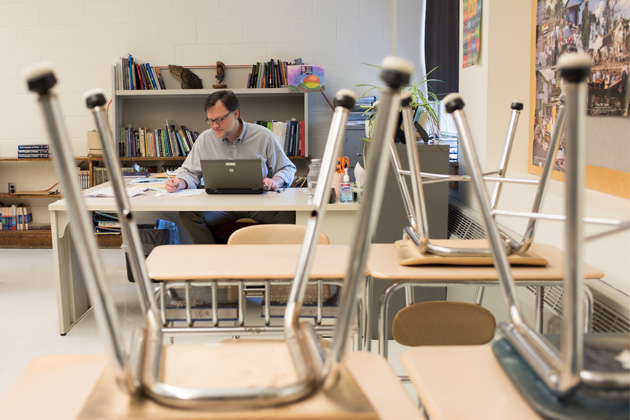
As a public high school teacher, Casey Deane sees the effects of school choice on public schools every day. Deane lives in a “choice” town, Marlboro, but works as a social studies teacher at Union High School in neighboring Brattleboro. Over the years, Deane has observed relatively well-off and educated families using vouchers to exit the public system, leaving behind low-income and disabled students. About one-third of Brattleboro’s high school students qualify for free or reduced price lunch.
“Students whose families are engaged are able to shift to ‘better’ schools and that only spirals the public school system into deeper dysfunction,” said Deane, who has been teaching in Vermont public schools for about 25 years. “The economic discrepancy that we have now has been broadened and it really affects the classroom.”
About 45 percent of the students in choice towns around Brattleboro attend private schools in and outside of the state, accounting for about $1 million in voucher spending, according to a ProPublica analysis of state data. For cash-strapped schools like Deane’s, the taxpayer dollars could make a significant difference. “For $75,000, you could get two brand new teachers or one veteran teacher,” he said.
Partly for financial reasons, Marlboro native Aliza Racine used her voucher to go to Union High, where Dean teaches, rather than private school. Both of her parents work in the logging industry, and her mother also runs a home cleaning business. “Do I really want to have my parents go into debt just to pay for high school?” she said in an interview.
Now a junior at the University of Vermont, where she majors in political science, Racine enjoyed Union High. She was challenged academically, took four years of dance classes and even traveled on a school program to Costa Rica. But, she said, many students go to private school with the help of vouchers because of a stigma against public education.
“The public school has a negative connotation that it’s not as good or up to the same standards of private schools,” said Racine. “If you do take advantage of what the public system has to offer, it can be just as good.”
While the voucher program funnels public money out of state, it also lures families to Vermont. Bill Cobb, a lawyer, and his family left Brooklyn, New York, more than a decade ago because “we weren’t sure that the public schools would be good for our kids,” he said. After a brief stay in Connecticut, they moved to a “choice” town in Vermont.
His wife had grown up in Vermont’s Northeast Kingdom, a rural area speckled with school-less towns, and she understood the educational landscape. The Cobbs have used vouchers to send their two sons to Milton Academy, a boarding school south of Boston.
“Consumers appreciate having the choice that we have,” he said. “Once you got [the voucher], you don’t want to give it away.”
Cobb paid the Milton tuitions with a combination of his own money, vouchers and school financial aid, he said. According to Milton’s website, Cobb and his wife have donated to the private academy for at least three consecutive years.
Vermont should expand the voucher program to all residents, regardless of whether their towns have public schools, Cobb said. “If this was the system everywhere, people would be happier,” he said. “Consumers would be excited to know that they could send their kid wherever they want, and let supply and demand create new schools and competition.”
The national debate over vouchers is starting to resonate in Vermont. Kevin Chavous gave the keynote address at a National School Choice Week event in Montpelier, the state capital, in January. He’s a founding board member and executive counsel for DeVos’ former school-choice advocacy group, the American Federation for Children.
Before an audience of private school students and choice supporters, Chavous commended the state for having “the oldest school choice program in the country.”
“I wish there was the same program in every other state,” he said. “Right now, there are those who are talking about backing away from this. Don’t do that. Don’t go backward.”
